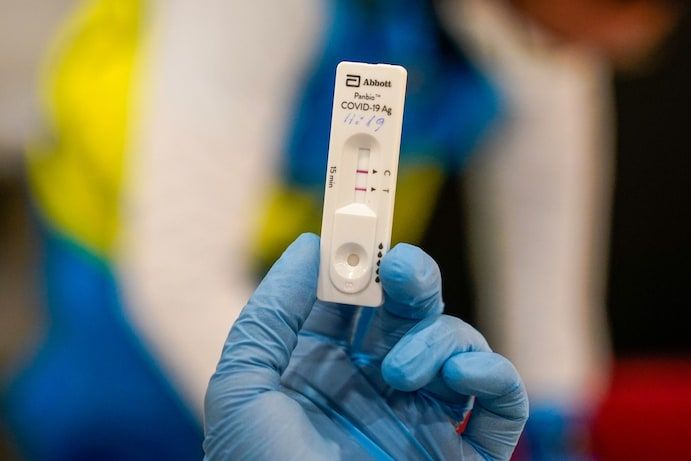When you have covid, here’s how you know you are no longer contagious

The Washington Post is providing this news free to all readers as a public service.
Follow this story and more by signing up for national breaking news email alerts.
Update: This article was updated Aug. 11 with revised guidance from the Centers for Disease Control and Prevention and the Food and Drug Administration.
You’ve got covid-19. When can you exit isolation? If you do resume activities outside your home, can you be sure you’re no longer contagious?
It’s complicated. Be forewarned: Guidelines from the Centers for Disease Control and Prevention are nuanced but a little confusing.
On Aug. 11, those guidelines were reissued by the CDC, and there are some new wrinkles — as we’ll explain below — but one thing did not change: You do not need a negative coronavirus test to exit isolation. This has been a contentious issue. Several infectious-disease experts said they believe patients with covid should have a negative antigen test — which gives results within minutes — before exiting isolation. The CDC continues to leave that as an option and does not explicitly recommend it.
The important thing to consider, experts say, is that every person and every case of covid is unique. There is no hard-and-fast rule for how sick a person will get or how long a person remains infectious. The guidelines offer a general framework, but patients should take into account their circumstances, priorities and resources to assess risk.
What to know
How long should I isolate if I have covid?
Return to menuThe coronavirus has the tricky feature of being transmissible even before the infected person has symptoms. In general, the peak period of virus shedding starts about a day or two before symptoms appear and continues two or three days after.
Even though a person is less likely to transmit the virus later in the course of illness, it’s still possible. Research shows that people continue to shed virus that can be cultured in a laboratory — a good test of the potential to pass along the virus — for about eight days on average after testing positive.
In another report, researchers at the University of Massachusetts Chan Medical School found that 30 percent of patients were still testing positive on a rapid antigen test 10 days after their infection was confirmed through a sensitive PCR molecular test.
Testing positive does not mean a person is certain to pass along the virus to someone else, however. And experts say transmission beyond 10 days is very unlikely even if a person is still testing positive. But someone who is still testing positive may want to continue wearing a mask and limiting contact with highly vulnerable people.
The CDC calls for patients to isolate for at least five days. On Day 6, you can end isolation as long as your symptoms have improved and you have been fever-free for at least 24 hours without taking fever-reducing medicine. The CDC has a calculator on its isolation and quarantine webpage to help people figure this out.
A potentially confusing point: Day 1 of your isolation, according to the CDC, is the day after you start feeling symptoms or test positive. (So, if you have a sore throat on Monday afternoon, that is Day 0 and Tuesday is Day 1.)
Even if you test negative, wear a well-fitting mask through Day 10 if you must be around others at home or in public, the CDC guidance states. Don’t travel.
The new guidance released Aug. 11 offers a take-off-your-mask option: Get two negative tests in a row after the end of the five-day isolation period. Importantly, the tests should be 48 hours apart.
If the test is positive after the five-day isolation period, you should continue to isolate for a full 10 days.
(Separately, the Food and Drug Administration on Aug. 11 produced a new recommendation for people who are concerned about exposure to the virus, or are suffering covid-like symptoms, but have tested negative once and never tested positive. The FDA’s advice: Double-check that negative test with a second test 48 hours later. The FDA cited evidence that many people have been testing negative on antigen tests only to test positive a couple of days later. People who have no symptoms but think they were exposed and potentially infected should have a third test after another 48 hours, the FDA advised.)
Wait. Shouldn’t I test negative on a rapid test before leaving isolation?
Return to menuThe CDC guidance on this is confusing. It does not explicitly recommend that you have a negative test to end isolation.
But many experts think rapid at-home tests, also known as antigen tests, should be used to exit isolation.
That’s what happened with President Biden, who tested negative twice before leaving isolation. (Biden, who was taking the antiviral Paxlovid, experienced a "rebound" infection and went back into isolation.) Also, experts point out that rapid tests are more readily available than last December, when the CDC released this guidance.
"Given that a substantial portion of people do have a rapid positive test after five days, I think an updated recommendation should include people having a negative rapid test before coming out of isolation for covid," Tom Inglesby, director of the Johns Hopkins Center for Health Security, said in an email. He was the Biden administration’s senior adviser on testing from December until April.
"A negative antigen test is fairly reassuring that you are not able to transmit infection to other people anymore," said Amy Barczak, an infectious-diseases expert at Massachusetts General Hospital who has researched how long patients with covid can shed virus. In a recent study published in the New England Journal of Medicine, she and colleagues found that, on average, people infected with the omicron variant of the virus can shed virus that can be grown in a lab for eight days.
Should I repeat the rapid test if it is negative?
Return to menuBarczak says that for healthy people, if you test negative on a rapid antigen test on or after Day 5, "you are unlikely to be contagious to other people."
For people with special concerns about passing along the virus, an extra test is not a bad idea. In symptomatic people, clinicians sometimes recommend a second rapid test to be sure. Biden, for example, tested negative twice before leaving isolation the first time.
Michael Mina, a former Harvard University infectious-disease epidemiologist and immunologist who is an expert on rapid tests, said two tests 24 hours apart might provide extra security, like a double lock on your door. If people have access to tests, then "two tests in a row is just better form, better protection, than one negative test."
When should you take a PCR test vs. a rapid at-home test?
Return to menuA PCR test, a type of molecular test, looks for the virus’s genetic material. The tests can detect even the tiniest amounts of virus, before you have enough in your body to spread it to other people. They are more useful early on as a confirmatory test to see if you are sick with covid but are not useful to determine whether you are infectious to others, said Albert Ko, an epidemiologist and infectious-diseases physician at Yale University.
If you develop covid-like symptoms, the CDC recommends that you get tested immediately. A negative PCR test in a symptomatic person means it’s highly unlikely you have covid.
If you had close contact with someone with covid and then tested negative with a rapid test, you might want to get further assurance that you aren’t infected. In that case, you can take a PCR test, Ko said. Most PCR tests must be analyzed by a lab, and results can take a few days.
A PCR test after you’ve been sick is not really practical, because "for the average healthy person, the PCR test is going to stay positive for longer than they’re actually infectious," Barczak said.
Rapid antigen tests are more practical than PCR tests for determining quickly whether you are capable of transmitting the virus. If you’re symptomatic, an antigen test will be more reliable, because your body is putting out a lot more virus to detect. But even without symptoms, people can test positive on a rapid antigen test and be a risk to others. Most at-home tests provide results in 10 to 20 minutes using samples collected with a nasal swab.
Because rapid tests provide results quickly and are essentially contagiousness tests, people should use them — even if they feel fine and have no symptoms — right before they plan to attend indoor events or large gatherings, especially if they expect to be around people more vulnerable to covid, including those with weak immune systems or others at higher risk of getting infected.
Coronavirus: What you need to know
The latest: The CDC has loosened many of its recommendations for battling the coronavirus, a strategic shift that puts more of the onus on individuals, rather than on schools, businesses and other institutions, to limit viral spread.
Variants: BA.5 is the most recent omicron subvariant, and it’s quickly become the dominant strain in the U.S. Here’s what to know about it, and why vaccines may only offer limited protection.
Vaccines: For people under 50, second booster doses are on hold while the Biden administration works to roll out shots specifically targeting the omicron subvariants this fall. Immunizations for children under 5 became available this summer. Here’s what to know about how vaccine efficacy could be affected by your prior infections and booster history.
Guidance: CDC guidelines have been confusing — if you get covid, here’s how to tell when you’re no longer contagious. We’ve also created a guide to help you decide when to keep wearing face coverings.
Where do things stand? See the latest coronavirus numbers in the U.S. and across the world. The omicron variant is behind much of the recent spread.
For the latest news, sign up for our free newsletter.












